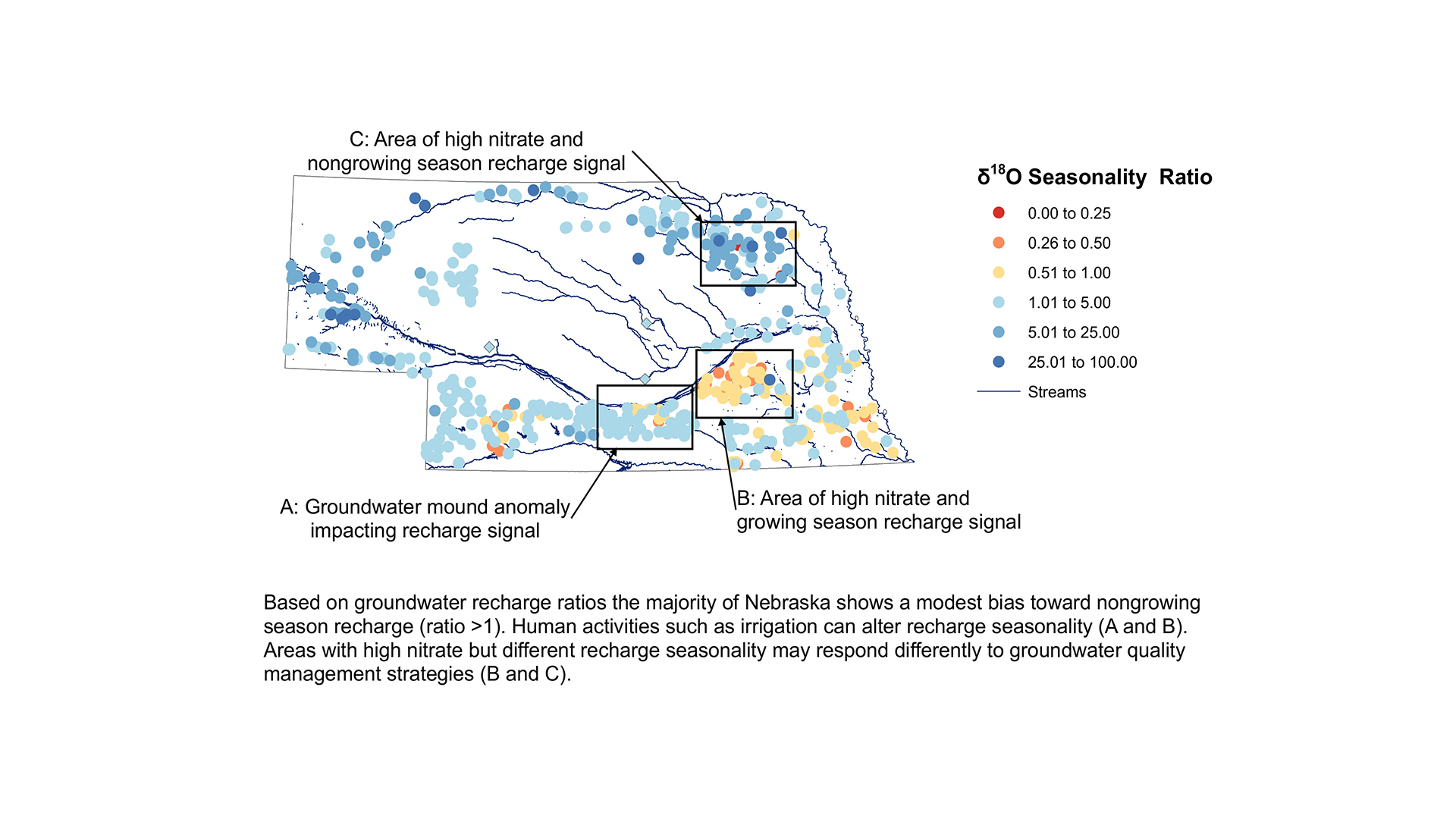
When it rains, and even when it pours and floods like it did in Nebraska in late 2018 and through much of 2019, the precipitation that hits the surface doesn’t always factor in to recharging the state’s vast and vital groundwater supply. In fact, the majority of precipitation doesn’t reach those depths.
So, when does it most often happen? A recently published study led by University of Nebraska-Lincoln School of Natural Resources PhD candidate Mikaela Cherry found that winter precipitation reloads most of the state’s groundwater supply.
And by learning when groundwater is recharging, Cherry said, that could reinforce current efforts to limit how much nitrate reaches the supply.
Cherry said that exploring the water quality aspect of the research project wasn’t part of the initial plan, but turned out to be a key unforeseen benefit.
“When we approached the project, it was more about finding the when,” she said.
Cherry started her PhD program at UNL two years ago, and her advisor, UNL groundwater hydrologist Troy Gilmore, told her about a trove of data collected in 2011 by former UNL faculty member John Gates, who coordinated with Nebraska’s Natural Resources Districts to gather nearly 800 groundwater samples from across the state that year.
"He said, 'Here you go,' and that's how I started working on it," Cherry said, laughing.
The samples allowed for an examination of the isotopic composition of groundwater found throughout Nebraska, and further allowed Cherry and the research team that assisted her study to play a match game of sorts. They compared about 600 of the groundwater samples with corresponding precipitation data. By analyzing the groundwater and precipitation samples’ respective oxygen-18 and hydrogen-2, or deuterium, isotopes, the researchers were able to calculate a seasonality ratio to find out when groundwater samples showed a similar isotopic makeup to winter or summer precipitation. Though there were some areas where groundwater supplies recharged from summer precipitation, the majority of the state saw a winter bias.
Nebraska’s summers are typically wetter than the winter months, so why does the recharge happen more often during a drier season? There are several reasons, Cherry said. One is that potential evapotranspiration exceeds rainfall, meaning that there isn’t excess water available that can become groundwater recharge. Human impact is another reason. Nebraska’s groundwater supply is frequently used for irrigation-powered agricultural operations. In areas of intensive canal irrigation where the Platte River is the source, Cherry found what appears to be a non-growing (winter) season recharge ratio, but is mostly Platte River water recharged through canals. In some intensively pivot-irrigated areas, Cherry wrote in the paper, the water cycle has shifted the recharge signature toward the growing season.
“In areas with heavy pivot irrigation, it does look like it's happening more in the summer and we're not really sure why,” Cherry said. “It might be that people are over-irrigating, and you have precipitation plus irrigation that leads to recharge in the summer. Or it might be that something to do with the process of irrigation is altering the isotopic composition of groundwater, so it just appears to be more summer-based. Different types of irrigation can impact it differently, but we're not quite sure why.”
Cherry said that the research team was surprised that the data showed on such a fine scale when the groundwater recharged in areas with different types of irrigation. That information, she said, could help reinforce water management practices that strive to limit and reduce nitrate levels in Nebraska’s groundwater supply.
Formed when nitrogen and oxygen combine, nitrates are prevalent in manure and inorganic fertilizers used by many agricultural operations. Nitrate is water soluble, and passes through soil to the groundwater table, where it can settle for decades. If nitrate levels are high in drinking water supplies, consuming it can have adverse health effects, especially for babies. Treating nitrate-rich drinking water is possible, but it is a costly endeavor.
“By understanding what times aquifers are recharging and vulnerable to contamination we can improve water quality best management practices,” Cherry said. “An example of this might be fall fertilizer application. If we know that recharge is occurring in the non-growing season, then applying fertilizer during this time might mean more contamination than if the fertilizer was applied in the spring. Another issue is groundwater quantity. Climate change might shift precipitation patterns and timing as well as lengthen the growing season, which would impact the overall amount of precipitation that becomes groundwater. Since the majority of the state relies on groundwater for both drinking water and irrigation, these are areas where more information would help inform management decisions.”
The paper, “Recharge seasonality based on stable isotopes: Non-growing season bias altered by irrigation in Nebraska,” was published in the March 2020 issue of Hydrological Processes. It was written by Cherry, the lead author, and features contributions from; Gilmore, Aaron Mittelstet, UNL Department of Biological Systems Engineering assistant professor; Didier Gastmans, Environmental Studies Center of Sao Paulo State University (UNSEP); Vinicius Santos, Environmental Studies Center of UNSEP; and Gates, CropMetrics.
Funding for the research was provided the National Institute of Food and Agriculture, Nebraska Environmental Trust, and the U.S. Department of Agriculture - National Institute of Food and Agriculture.
Cory Matteson, SNR Communication